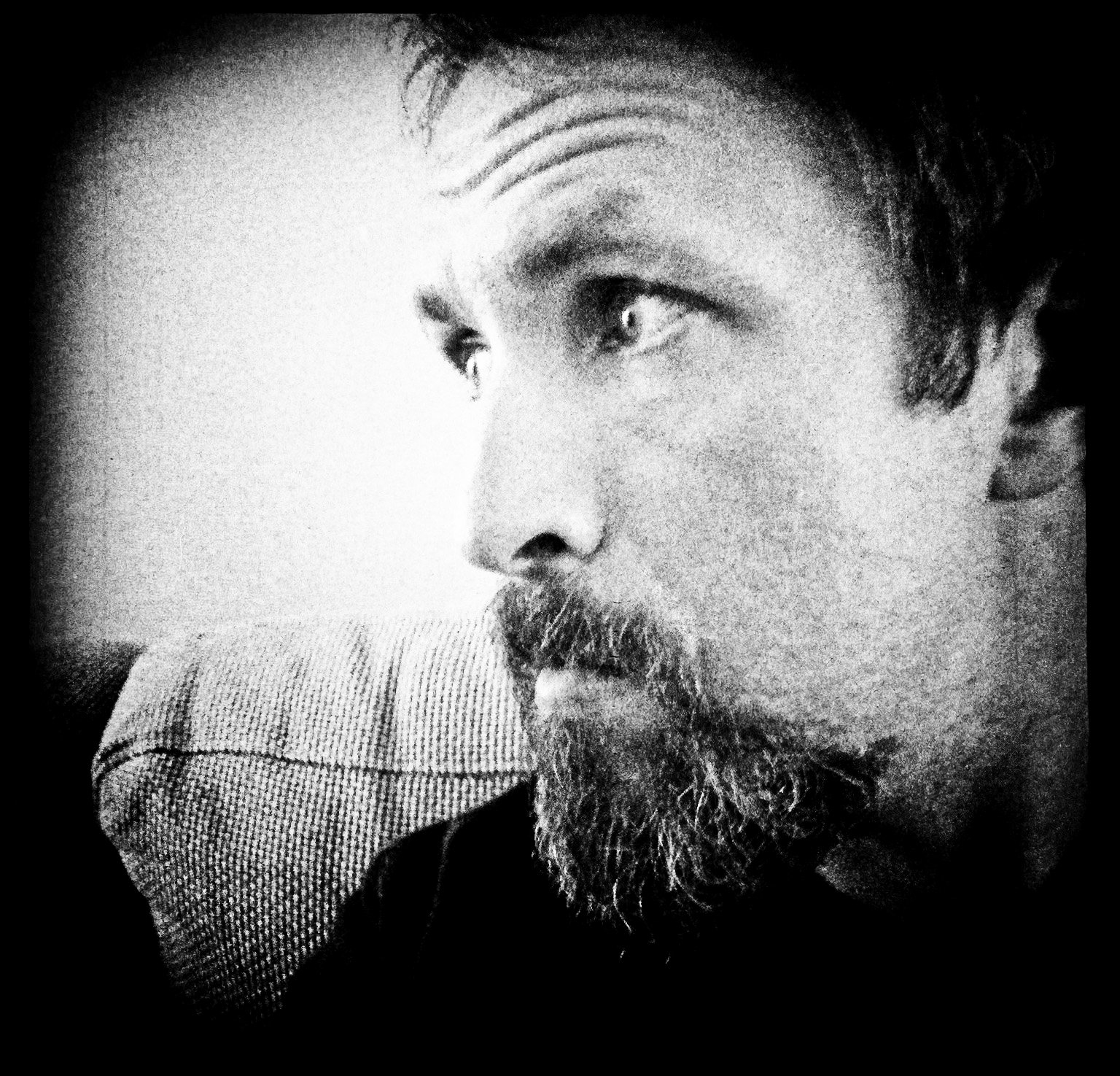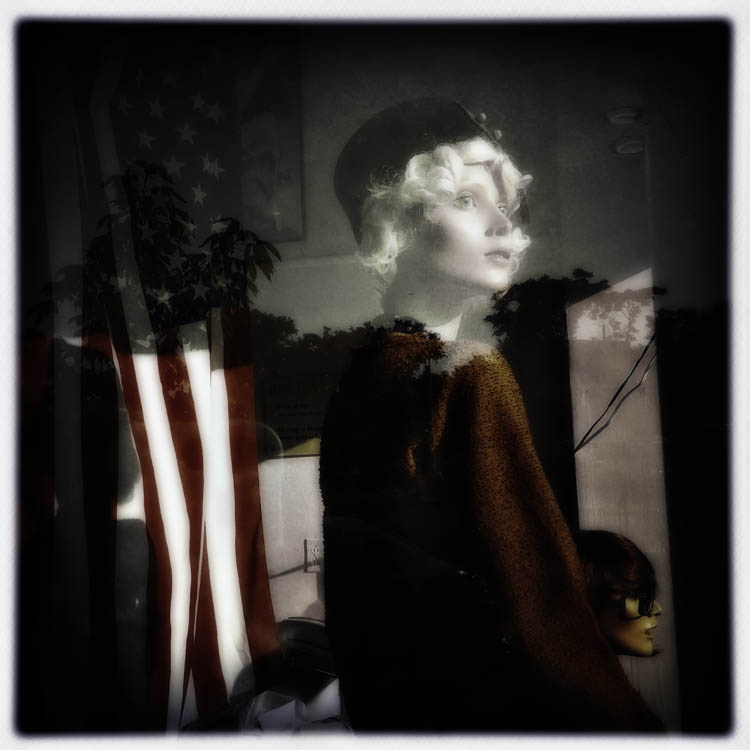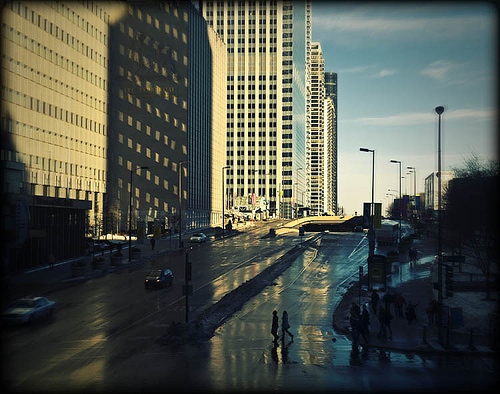 Matt Golosinski is a local photographer, musician, writer, and the latest artist to be featured in our ongoing exhibition series Local Art @ EPL. His show – titled Everyday Departures – is currently on display on the 2nd floor of EPL’s Main Branch where it reveals the extraordinary aspects of ordinary moments captured during meditative walks through the local cityscape. You can catch the stunning photographs of Everyday Departures through the end of October, and after that, you can learn more about Mr. Golosinski’s art by visiting his Noir Imp Images website. We recently spoke with Mr. Golosinski via email about the power of Parliament-Funkadelic, the tradition of the flaneur, fixed-focal length prime lenses, and authenticity in art.
Matt Golosinski is a local photographer, musician, writer, and the latest artist to be featured in our ongoing exhibition series Local Art @ EPL. His show – titled Everyday Departures – is currently on display on the 2nd floor of EPL’s Main Branch where it reveals the extraordinary aspects of ordinary moments captured during meditative walks through the local cityscape. You can catch the stunning photographs of Everyday Departures through the end of October, and after that, you can learn more about Mr. Golosinski’s art by visiting his Noir Imp Images website. We recently spoke with Mr. Golosinski via email about the power of Parliament-Funkadelic, the tradition of the flaneur, fixed-focal length prime lenses, and authenticity in art.
Evanton Public Library: Can you tell us a little about your background as an artist? How did you get started in art? Was there something specific in your life that sparked a need to create? What drove you in the beginning? What drives you now?
Matt Golosinski: Improbably, perhaps, I first gained a sense of art’s power while listening to an old 45 recording of Parliament-Funkadelic’s “Flashlight” in 1978. Earlier, I’d also been exposed to lots of music—Beach Boys, Dylan, Kingston Trio, Marty Robbins, old weird Americana from the 1940s and 1950s. But I distinctly remember hearing Parliament and having the hair stand up on my neck, from the opening keyboard riff straight through to the fade. It came as a revelation. All that complex sound swirling together beautifully, direct from the soul of musicians who obviously believed they were on a mission to spread a message: Funk Power. Well, I wasn’t sure what they were after, exactly, but I felt the power, even in my white, middle-class, prepubescent world. So I knew that art had the ability to connect with people, across demographic and cultural lines. That was deeply appealing to me.
Then, too, as early as first grade I’d been thrilled with books and libraries. I plowed through tons of fiction. At some point I got hooked on Dickens, Dostoyevsky, Tolkien. These were people who created remarkable worlds into which I gladly entered. Again, the power of art/artifice to connect people and ideas, different ways of experiencing the world, excited me. In addition, I grew up in a house with all kinds of reading material—from the Harvard classics to National Geographic and medical texts to various Time-Life series (subjects: The Old West, UFOs and the Paranormal, True Crime, etc.). So people who asked questions and tried to make discoveries were heroes to me. They could be scientists, musicians, writers, philosophers, even advanced charlatans. The common thread was they cared enough to look more deeply at the world. In so doing, they tended to cultivate rather interesting personas themselves—turning their own lives into an art form. Think Andy Warhol, to cite one obvious example.
 Fundamentally, art is an interrogation of the world: a dynamic, contingent, contradictory, messy chat. Art can get you out of bed in the morning. It can form a lens through which you look. For some, art performs a function quite similar to religion, in that it forms a bulwark against life’s challenges and uncertainties. I’m not suggesting that art provides certainty, but it does let you, like King Lear, shake a fist at the heavens and fight back a bit, even when you know you’re losing. There’s strong medicine in that.
Fundamentally, art is an interrogation of the world: a dynamic, contingent, contradictory, messy chat. Art can get you out of bed in the morning. It can form a lens through which you look. For some, art performs a function quite similar to religion, in that it forms a bulwark against life’s challenges and uncertainties. I’m not suggesting that art provides certainty, but it does let you, like King Lear, shake a fist at the heavens and fight back a bit, even when you know you’re losing. There’s strong medicine in that.
EPL: How do you describe your art? Do you see yourself as fitting in with any particular artistic movements or styles? Do you work in any other mediums in addition to photography?
MG: With respect to photography, I draw inspiration from a range of people. Everyone cites Cartier-Bresson as a guiding light, and for good reason. Me too. I also like Kertesz, Callahan, Sudek, Koudelka, Salgado, Hockney, Sugimoto. I could name three dozen more. (I’m a maximallist.) What would link them all, despite their differences, is a commitment to personal vision and a passion for needing to do the work. It’s authenticity that I admire, whether we’re talking about visual arts, music, or literature.
I feel most connected, though imperfectly, to the old tradition of the flaneur—a French word that refers to a person who rather aimlessly strolls the city. Aimless except for a desire to maintain a heightened awareness—maybe better to think of it as a Zen awareness, one that’s not too “tight” and not too “loose.” Let the world come to you, but at the same time approach the world with a sense of possibility, a reverence for happenstance. And a quick eye to catch that fleeting moment as the light shifts and just before the scene disappears back into eternity. Of course, these days if you’re out with a camera staring for 5 minutes at a pattern on the wall under the CTA viaduct people will ring the police… But sometimes that moment, before the police arrive, can produce a secret treasure that nearly everyone else walks right past.
EPL: Can you give us a window into your creative process for “Everyday Departures?” More specifically, could you take us along on one of your meditative walks that captured a photo? How did the photo reveal itself?
MG: Well, for starters I don’t use zoom lenses; I use fixed-focal length prime lenses. That means I force myself to move more to explore whatever I’m looking at. I can’t rely on the camera/lens to do this for me, as is more often the case with zooms. Using primes slows you down just enough to contemplate what you’re exploring a bit more deeply than you might otherwise. That said, you still have to be quick, though you may well miss a shot that a zoom would have let you capture. But that’s OK. The world is brimming with missed shots, and you have to let them go. What’s important is that you connect with YOUR shot, in that moment. When I head out with the camera, I may have a vague idea of what I want to find—architecture, street details, flowers, abstracts, whatever. Sometimes I take long walks, often trying to make at least minor detours from the usual path to see if  I can discover something new. Taking the typical route, but with fresh eyes, can also yield some interesting results. I let my intuition help, trying not to “overthink” things. Often, the picture reveals itself. You just know, instantly, when you have something worth attempting. You don’t always succeed, but you make the attempt. The tricky bit is that the instant really is just that: a fleeting moment.
I can discover something new. Taking the typical route, but with fresh eyes, can also yield some interesting results. I let my intuition help, trying not to “overthink” things. Often, the picture reveals itself. You just know, instantly, when you have something worth attempting. You don’t always succeed, but you make the attempt. The tricky bit is that the instant really is just that: a fleeting moment.
In one sense, photography—certainly street photography, where you’re trying to engage with life in the city as it happens—is down to chance. You’re in the right spot at the right time and you “click.” But that’s really not the full story. You have to be aware of your surroundings and their potential to offer up something interesting. You seek out a context that could prove beneficial to your efforts, then you go in having already set your camera’s functions, given the light and other environmental variables, so that you have the best chance of getting a good shot in those circumstances. This mitigates the chance variables.
EPL: How do your years as a practicing musician influence your photography?
MG: Well, as a musician I always respected, and strove for, authenticity. Take the Velvet Underground for example. Plenty of pretty rough-sounding tracks, but a real commitment to their art, a real unapologetic pursuit of the authentic, despite what anyone outside the band (excepting maybe Warhol) would think. They were true to themselves and to their aesthetic ideals. It didn’t always sound pretty. It didn’t flirt with the mainstream. But there was a real power and vision in that music, if you had the ears for it. You can easily say the same for the old Blues masters—guys with the word “Blind” in their names whose art, etched into antique 78s, offered an authentic glimpse into their hardscrabble lives. They were the original Punk rockers, back in the 1920s and ‘30s, playing $12 guitars from Sears. Check out Blind Willie Johnson, Willie McTell, Son House. I came to these guys backwards, after discovering bands like the Sex Pistols, Roxy Music, The Jam, XTC, The Damned, and many others. These latter-day acts were refreshing for similar reasons. They didn’t necessarily worry about anyone else telling them what they could or could not do. They just plugged in and started cracking away to distill their experiences into art. That doesn’t mean you don’t rehearse or try to gain greater technical skill over time. You do. As a musician I certainly did. But what gets you out the door, with a camera or guitar, is the sense of adventure, a sense of urgency. The sense that you have a story to tell and a means of telling it. If others tune in, great. If not, that’s fine too. Because on some deep level you have to do what you’re doing regardless of critical reception. Put the art first and you’re always OK.
EPL: What are your future goals and plans as an artist? Do you have any plans to develop “Everyday Departures” further? Are you currently working on any other projects?
 MG: I have opportunities to travel, including to Paris, Singapore and the Middle East, so I’m looking at deepening the approach in new contexts. But great discoveries can be made right in your backyard. Look at Emily Dickinson, a poet reputed never to have traveled more than about 50 miles from her birthplace. Then there’s the Czech photographer Josef Sudek who conjured up magic from within his cluttered studio and in his garden. We could discuss many other examples. So it’s not about just seeking new terrain out there. It’s always about preparing the terrain in here, inside our hearts and heads, and then making the connections that take us forward as people who can, one hopes, share a little of the insight and discovery with others in ways that are beneficial.
MG: I have opportunities to travel, including to Paris, Singapore and the Middle East, so I’m looking at deepening the approach in new contexts. But great discoveries can be made right in your backyard. Look at Emily Dickinson, a poet reputed never to have traveled more than about 50 miles from her birthplace. Then there’s the Czech photographer Josef Sudek who conjured up magic from within his cluttered studio and in his garden. We could discuss many other examples. So it’s not about just seeking new terrain out there. It’s always about preparing the terrain in here, inside our hearts and heads, and then making the connections that take us forward as people who can, one hopes, share a little of the insight and discovery with others in ways that are beneficial.
EPL: How do you find Evanston and the Chicagoland area as a place to work and exhibit as an artist? What inspires you as an artist about the community where you live?
MG: Chicago is a marvelous city with an inexhaustible store of material for artists. It’s a unique place. You can find it all here—architecture, art, music, sports, theatre, diverse neighborhoods and people. I’m not crazy about the winters, but that’s a cliché point, albeit one I feel deeply. Evanston, too, is a great little city, with a lot of urban feel to it while not being awash in all the noise and negative urban stuff that you might find elsewhere. Being right along the lake, it also seems like a big park at times. I like places that are more manageable, not so overwhelming. As I get older, I like more quiet. I value an environment that lets you get out for a walk and to think in peace. And there is a nice little photographic community here too, some of whom are involved with the Perspective Gallery on Chicago Ave. As a photographer, this area lets you pursue a range of expressive possibilities, from landscape to street.
Context may vary but, as an artist, the most important element is your own belief in your own voice and vision. Do it for yourself. Everything else that derives from the effort is a bonus.
Interview by Russell J.
